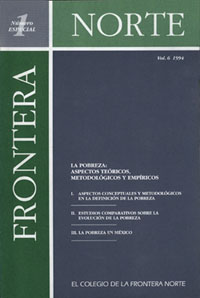Overcoming Poverty in the Developing: World Lessons of Experience
Main Article Content
Abstract
Article Details
Authors publishing work in this journal agree to the following conditions:
Authors retain copyright and assign first publication rights to the journal Frontera Norte (RFN), with the texts registered under an Attribution-NonCommercial-NoDerivatives 4.0 International Creative Commons license (CC BY-NC-ND 4.0), which allows third parties to use published material provided they give credit to the authors and acknowledge this journal as the first publisher.
They authorize the reproduction, publication, translation, communication, and transmission of their paper and all accompanying material, publicly and in any form and by any means; its public distribution in as many copies as required; and public communication thereof in any form, including making it available to the public through electronic means or any other technology, and solely for dissemination and scientific, cultural, and non-commercial purposes.
Authors may enter into further independent contractual agreements for the non-exclusive distribution of the version of the paper published in this journal (for instance, to include it in an institutional repository or personal webpage, or publish it in a book), provided it is not for commercial purposes and they clearly state that the work was first published in Frontera Norte (RFN) [and add the corresponding bibliographical record: Author/s (Year). Title of paper. Frontera Norte, volume (number), pp. doi: xxxx].
To that end, authors must submit the form assigning ownership of first publication rights, duly completed and signed. This document is to be uploaded in PDF format as a complementary file on the OJS platform.
This work is released under an Attribution-NonCommercial-NoDerivatives 4.0 International Creative Commons license (CC BY-NC-ND 4.0)..
References
This kind of headcount index is one of several measures that are necessary to get a reasonable idea of the dimensions of poverty in judging the effectiveness of public policy. Other indices relate to poverty gap (resources necessary to bring all the poor barely up to the poverty threshold as a proportion of total income necessary to support the entire population at the poverty threshold income) and distributionally weighted poverty gap (which estimates the poverty gap by attaching higher weight to the gap between actual income and the poverty threshold income the greater the poverty of the person concerned). For a discussion of these measures, see Martin Ravallion, Poverty Comparisons: A Guide to Concepts and Methods (Washington, D.C.: World Bank, 1992). For our present purpose a distinction among these measures seems unnecessary.
This paper, focused on broad trends and patterns, will not provide detailed statistical evidence. Estimates of the incidence of poverty and trends in the incidence of poverty are drawn from: World Bank, The World Development Report 1990 (New York: Oxford University Press, 1990); International Fund for Agricultural Development (IFAD), The State of World Rural Poverty, by I. Jazairy, M. Alamgir, and T. Panuccio (New York: New York University Press, for IFAD, 1992); or individual country studies usually made by, or reported in, World Bank documents.
This is the case for per capita income measured both in current dollars and in PPP dollars. In current dollars per capita income in East and South-East Asia in 1985 was 30 percent of that in Latin America and less than half of that in the Middle East and North Africa. Regional averages of per capita incomes in PPP dollars are not available, but a comparison of country-level estimates leads one to expect that their differences were in the same direction and very substantial. Latin America includes the Caribbean.
The present writer feels least certain about the circumstances and trends in Latin America. He would like to note that Latin America is the only region in which he did not have an opportunity of direct field experience.
International Fund for Agricultural Development (IFAD), op. cit.
Apart from the former Indo-Chinese countries (for which the turbulent history of the recent past and the absence of information act as major reasons for their exclusion from the present analysis) this list excludes one other major country of the region, the Philippines. Both development strategy and poverty outcome in the Philippines have been very different from what they have been in the countries of East and South-East Asia listed above.
Also, Thailand's record with respect to the change in inequality in the distribution of income is the worst among the countries in the group.
United Nations Development Programme, Human Development Report 1993 (New York: Oxford University Press, 1993).
Ibid.
World Bank, The East Asian Miracle (New York: Oxford University Press, 1993).
A.R. Khan, K. Griffin, C. Riskin, and Zhao Renwei, "Household Income and Its Distribution in China," The China Quarterly, December 1992.
The Grameen Bank in Bangladesh provides credit to the landless workers engaged in nonfarm activities at a rare of interest that is higher than the interest charged by other institutional sources of credit. The present writer has argued that one of the principal reasons why the poor have been the beneficiaries of the Grameen Bank program is that its credit has not been underpriced. For an analysis of many novel features of this program, see Mahahub Hossain, Credit for the Rural Poor: The Experiences of the Grameen Bank in Bangladesh (Dhaka: Bangladesh Institute of Development Studies, 1984).

